This post contains affiliate links, which means I may earn a commission if you purchase through those links (at no extra cost to you).
Learn how to make Clarified Butter, an easy process that removes the water and milk solids from whole butter. Clarified butter has a more concentrated, richer flavor, lasts longer in the refrigerator, and has a higher smoke point for cooking.
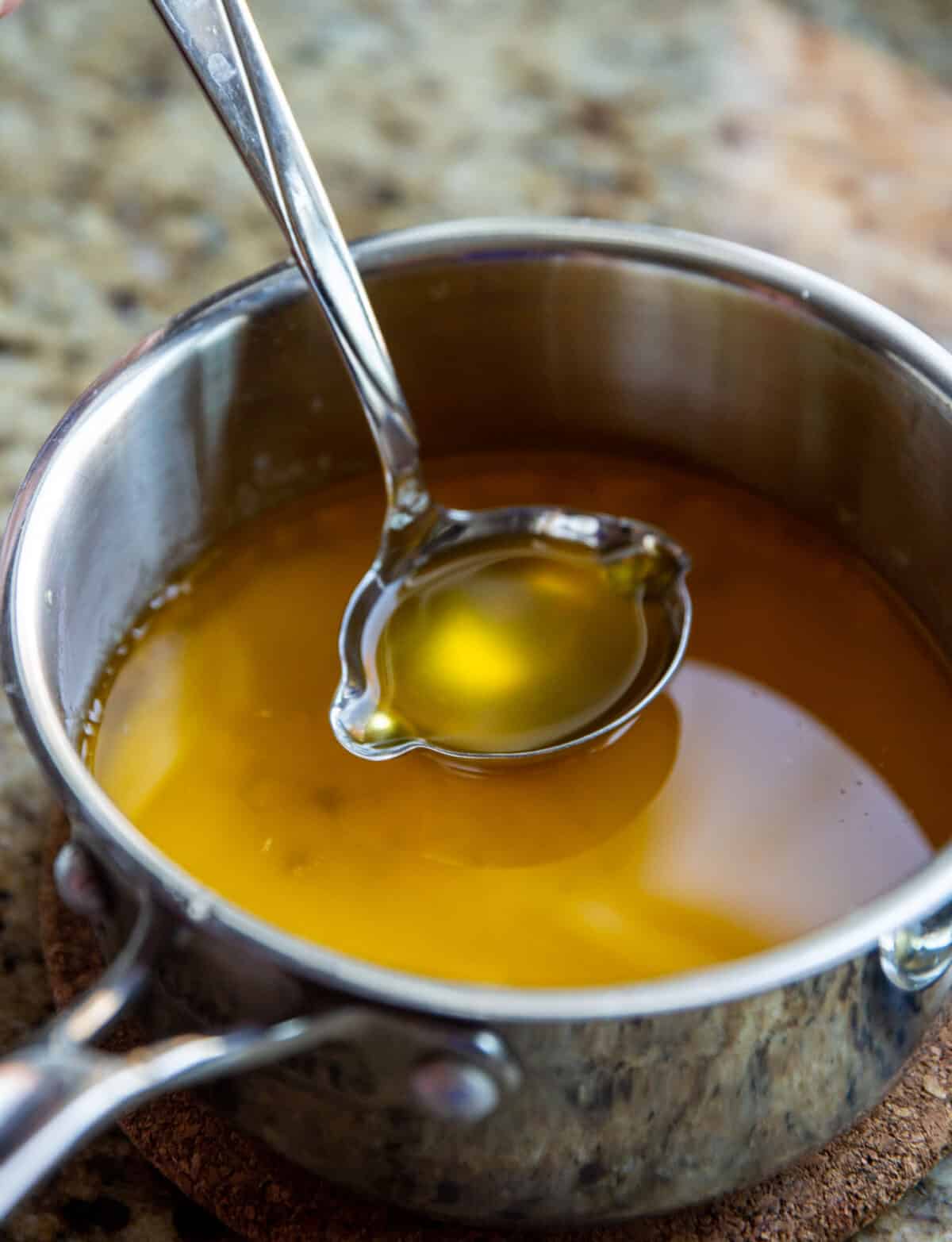
Meggan’s notes
When you make clarified butter, you skim milk solids off the top of melted butter and leave the released water in the bottom of the pan. The stuff in the middle, the liquid gold, is 100% pure butterfat.
This means a higher smoke point, a longer shelf life, a rich buttery flavor, and a more versatile substance great for making everything from stir-fries to sauces.
This recipe is not for Ghee, a specific type of clarified butter that is shelf-stable at room temperature, although I cover the differences and how to make it in the FAQ section.
Table of Contents
Recipe ingredients

At a Glance: Here is a quick snapshot of what ingredients are in this recipe.
Please see the recipe card below for specific quantities.
Ingredient notes
- Better butter: The best butter for clarifying is European-style, imported butter. These butters usually contain more milk fat than American butter (82% to 86% milk fat in European vs. 80% to 82% in American). After clarifying some store-brand or other inexpensive butters, I was left with what looked like a pan of yellow water. Not appetizing! If you are clarifying butter to make a delicious Hollandaise Sauce, choose a delicious butter (since Hollandaise Sauce is mostly butter). But, If you’re clarifying butter to make a stir-fry, the quality won’t be quite as important.
- Butter solids: You can lightly brown the butter solids (the layer you scooped off the top) in a small amount of clarified butter to make “browned butter.” Then, add to cookies, vegetables, soups, and mashed potatoes for extra butter flavor, or use as a condiment on bread.
Step-by-step instructions
- In a small saucepan over low heat, warm butter without boiling or agitation of any kind. As the butter melts, the solids rise to the top, and water sinks to the bottom. Sometimes the solids appear to bubble up from the bottom.
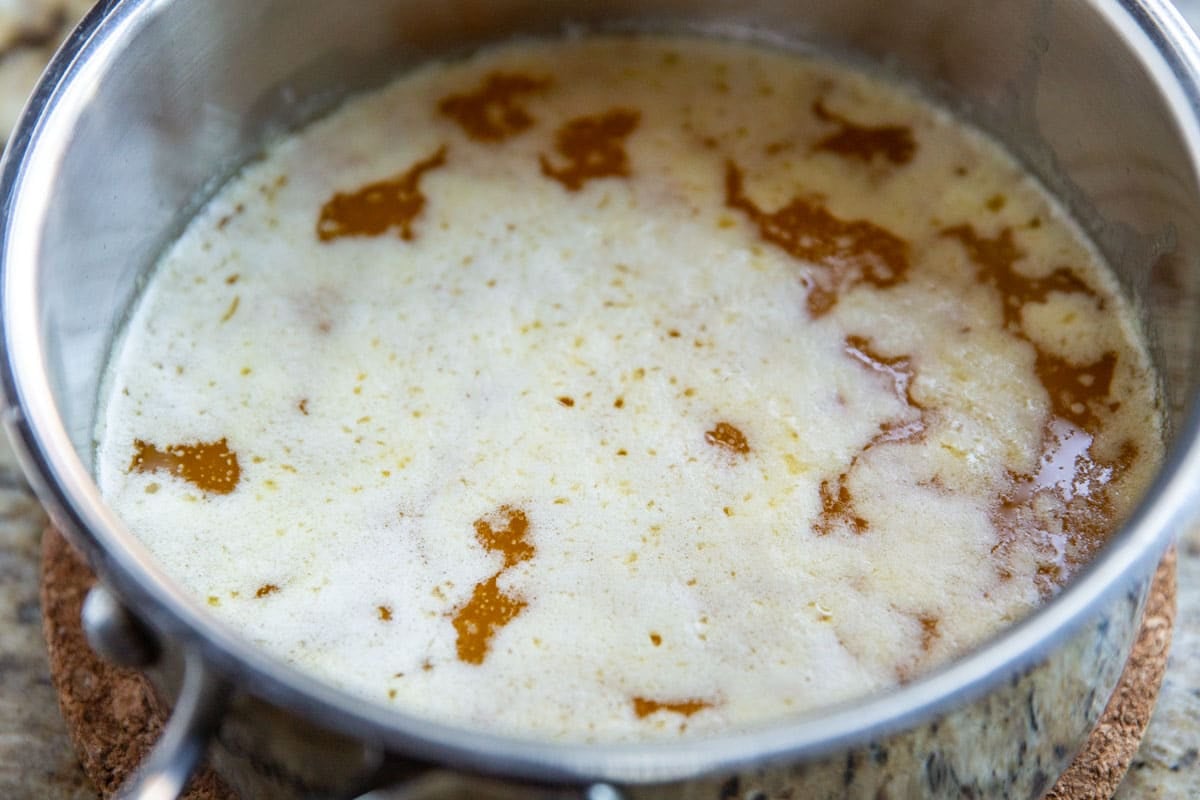
- When the butter is melted, skim the milk solids from the top using a ladle or slotted spoon (see notes for ideas of what to do with the solids).
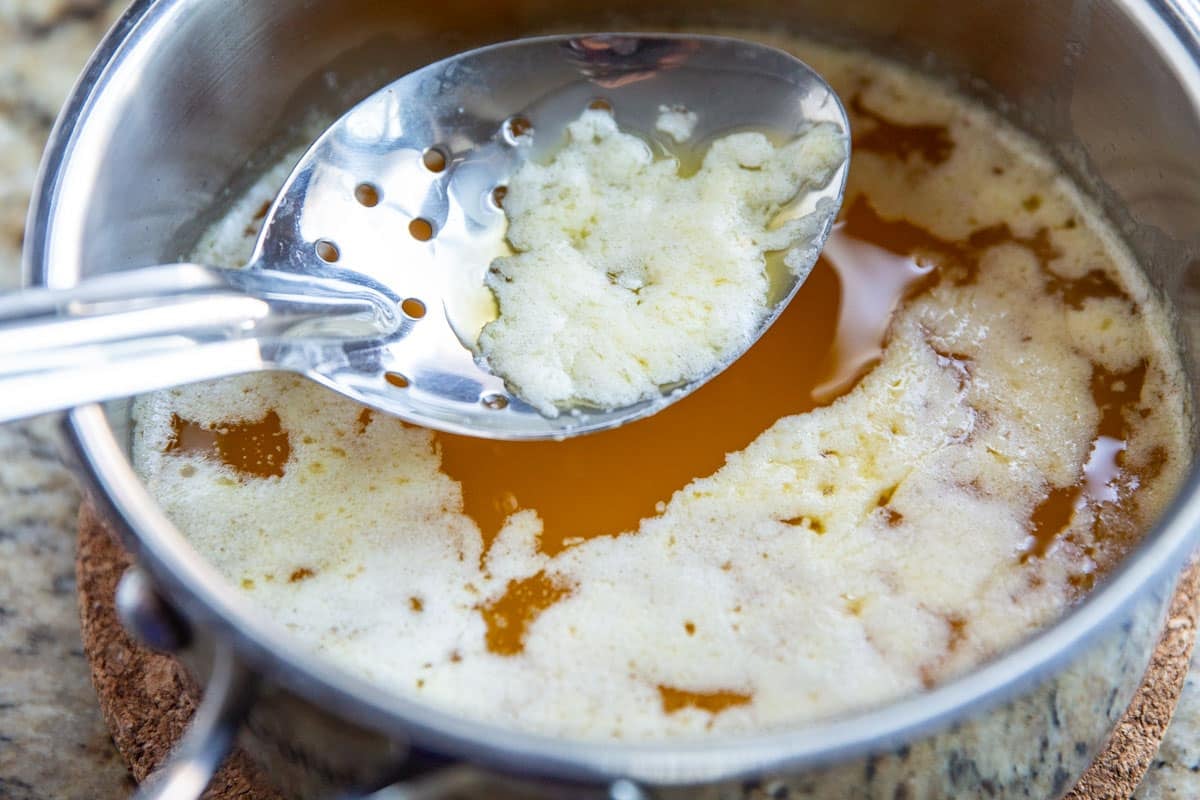
- When the skim solids have been removed, transfer the butterfat to a clean saucepan, bowl, or jar using a ladle. Leave the water in the bottom of the pot.
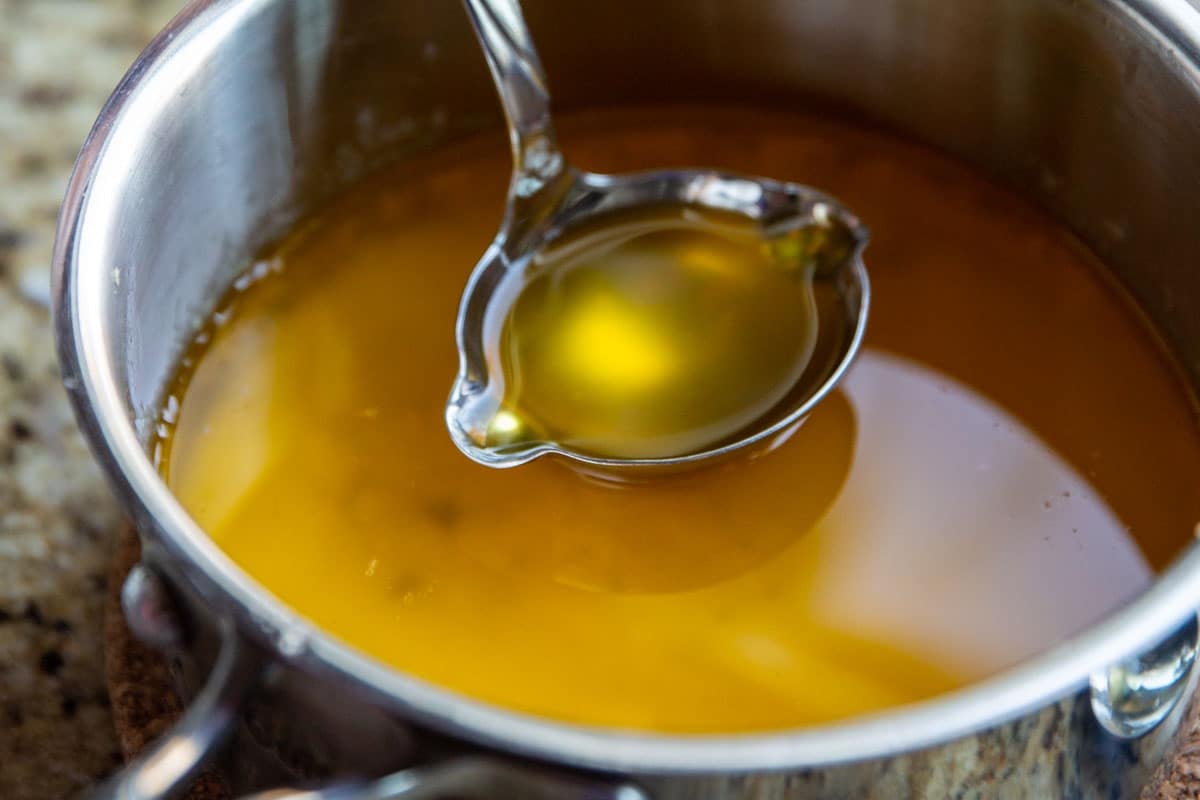
Recipe tips and variations
- Yield: 1 pound of butter yields about 12 ounces of clarified butter, enough for 8 servings, 1 ½ ounces (3 tablespoons) each.
- Storage: Store clarified butter in a jar the fridge for up to 2 months.
- Freezer: Pack in a freezer-safe container, label, date, and freeze clarified butter for up to 6 months.
- No slotted spoon: Strain your solids away with cheesecloth, a fine-mesh sieve, or fine-mesh strainer.
- Flavors: Add fresh garlic, herbs, and spices to your clarified butter. See Compound Butter 6 Ways for delicious flavor combinations for butter.
- Serving suggestions: Drizzle hot clarified butter over your next New York Strip Steak, Roast Beef Tenderloin, or Steak and Lobster for extra richness. Or, try on pancakes, crab legs, and roasted vegetables (especially potatoes). Clarified butter is also an ingredient in some Hollandaise recipes.
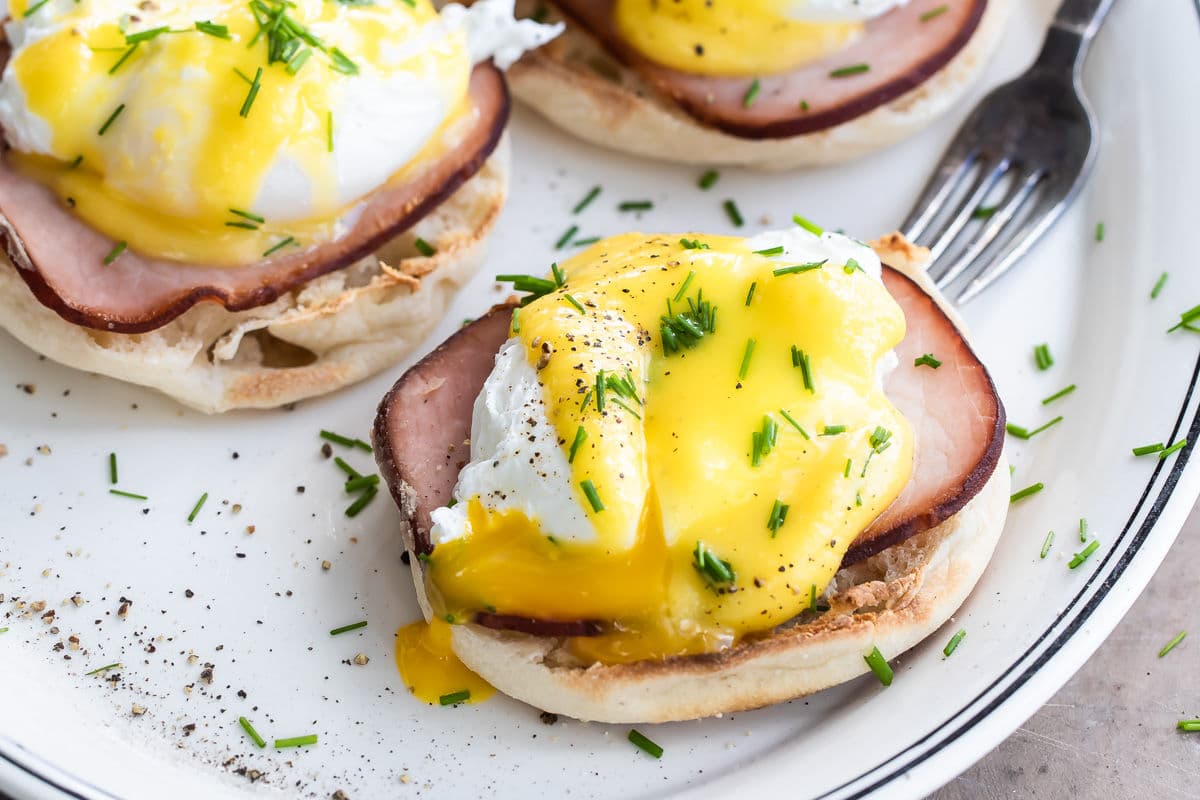
Frequently Asked Questions
Clarified butter and ghee are almost the same thing. They are both regular butter with the milk and water solids removed (leave pure butterfat). Ghee is a particular type of clarified butter normally used in Indian cooking.
Clarified butter is often made by melting butter, skimming off the foam, and leaving the water in the bottom of the pan. Ghee, however, is boiled rapidly over medium-high heat until the water in the butter bubbles and actually boils off, and the milk proteins brown. You strain the ghee to remove the milk solids, and the resulting butterfat, ghee, is pure and can be stored at room temperature for up to 3 months or 1 year in the refrigerator.
Because clarified butter is pure butterfat, it has a high smoke point (about 450 degrees) compared to regular butter (about 350 degrees).
The clarified butter method in this recipe does not produce shelf-stable butter and must be kept in the refrigerator. Ghee, which has been boiled for at least 10 minutes to remove the water, and then strained to completely remove all milk solids, is the shelf-stable version for up to 3 months or can be refrigerated for up to 1 year.
More ways to enjoy clarified butter
Beef Recipes
Best Beef Tenderloin Roast Recipe
Main Dishes
Surf and Turf
Mexican Recipes
Best Steak Fajita Recipe
Beef Recipes
Grilled Beef Tri Tip
Join Us
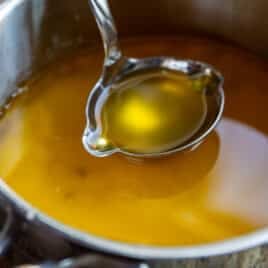
Clarified Butter
Ingredients
- 1 pound unsalted butter
Instructions
- In a small saucepan over low heat, warm butter without boiling or agitation of any kind.
- As the butter melts, the solids rise to the top and water sinks to the bottom. Sometimes the solids appear to bubble up from the bottom.
- When the butter is melted, skim the milk solids from the top using a ladle or slotted spoon (see notes for ideas of what to do with the solids).
- When the skim solids have been removed, transfer the butterfat to a clean saucepan or bowl using a ladle. Leave the water in the bottom of the original saucepan.
Recipe Video
Notes
- Better butter: The best butter for clarifying is European-style, imported butter. These butters usually contain more milk fat than American butter (82% to 86% milk fat in European vs. 80% to 82% in American). After clarifying some store-brand or other inexpensive butters, I was left with what looked like a pan of yellow water. Not appetizing! If you are clarifying butter to make a delicious Hollandaise Sauce, choose a delicious butter (since Hollandaise Sauce is mostly butter). But If you’re clarifying butter to make a stir-fry, the quality won’t be quite as important.
- Butter solids: You can lightly brown the butter solids (the layer you scooped off the top) in a small amount of clarified butter to make “browned butter.” Then, add to cookies, vegetables, soups, mashed potatoes for extra butter flavor, or use as a condiment on bread.
- Yield: 1 pound of butter yields about 12 oz. of clarified butter, enough for 8 servings, 1 ½ oz. (3 Tbsp.) each.
- Storage: Store clarified butter in the refrigerator for up to 2 months.
- Freezer: Pack in a freezer-safe container, label, date, and freeze clarified butter for up to 6 months.


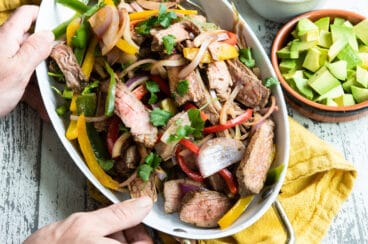
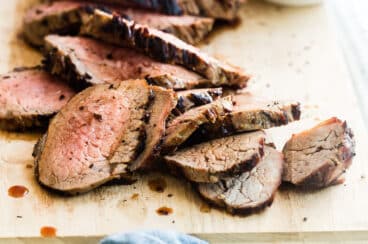
I thought clarified butter went bad faster?
Hi Jason, no. Clarified butter is really similar (but not identical) to ghee. Once you take out the protein and water, you are left with pure butter fat which lasts longer. I’ve actually seen other websites say that once you clarify the butter, you can leave it at room temperature, in the pantry, for a month. Personally I don’t feel comfortable doing that. They also say you can keep it in the fridge for up to a year… I wouldn’t do that either. But it lasts longer than regular butter. Thanks! -Meggan
Why do I need to use unsalted butter?
Hi Sarah, you don’t. I need to fix that. I used to be of the opinion that salted butter is better because “every company makes salted butter differently, you don’t know how much salt is in there, blah blah blah control the salt in your recipe by starting with unsalted butter.”
I now have the unpopular opinion that salted butter is just fine everywhere. My main reason is, I hate running out of salted butter and having to use unsalted butter on my toast. And furthermore, have you ever tried a butter and felt like – WOW THIS IS JUST TOO SALTY. No? Me neither. They pretty much all taste the same, I’ve never had an overly salty butter. Yes the companies make them different but it’s just a commodity and no one is jarringly different.
This opinion isn’t reflected in every post yet, but I’ll go update this recipe. Sorry for that and thanks for listening. /end rant -Meggan 🙂
I always wondered how they made ghee, I sure have eaten a lot of Indian food that contained it but I never knew the process of how to make it. Thanks for your description!
So what’s the CLARIFIED BUTTER? The stuff you skim off the top or what’s underneath it?
Fifty years ago I was taught to melt the butter and skim off the top. What you skim off the top is the CLARIFIED BUTTER. However, you don’t specify.
Hi Elissa, sorry this wasn’t clear. You skim off the top of the foam (milk solids) and discard it, and the yellow liquid (which looks a lot like oil), the fat, is the clarified butter. I hope this helps! Sorry for the confusion. I’ll fix the post. Thanks! -Meggan
Can homemade butter be clarified? I just made some last night from whipping cream. Can I clarify it now? I can’t see why not, but I just want to be sure. Thank you
Like you, I can’t see why not! I never tried that but it seems like it would work just fine. Good luck!
Happy to be explore your webpage! Clarified Butter is base for lot of Indian Cooking. It has lot of health benefits. Thanks for this post.
Get Danish “Lurpak”, it is the worlds best Butter, a pretty good reason, why most Bakery’s around the world use it 😉
where do you buy Lurpak butter. I live in N.Y.
Hi Georgina, it looks like you can order it from igourmet.com. I personally haven’t used this site (or the butter) but I see it listed there with people who seem to have purchased it recently and love it.
https://www.igourmet.com/shoppe/search.aspx?qry=lurpak
Good luck! -Meggan
🤗👌 Thanks!
Hi Meggan, thanks for the “how to” and what to use to achieve a really great result! Imported, unsalted is available in my city so, no problem. Thanks for listing the butterfat content – that is very helpful. How do you use the skimmed off milk fat and “water” so I don’t have to throw it away? Thank you again.
Hi MaryAnn! Thank you so much for the thoughtful comment. I honestly haven’t figured out what to do with the extra butter products (water and fat), but now that you mention it, I should definitely figure that out. I will comment again as soon as I have some ideas! Working on it now. 🙂 Thank you!
Continue browning them until you have toasted butter solids. Those can be added to everything: Cookies, Vegetables, Sauces, anything where you want a little delicious browned butter flavor 🙂
1) Will this work for butter on popcorn? 2) Does the butter have to be unsalted? We get no name butter from the store but its always salted b/c the unsalted one is always sold out or too expensive….3) Also, i know you said that the brand of the butter is important but I’m from Vancouver and the general grocery stores don’t have too many different brands -i havent paid too much attention but Im not sure if we would have the european ones here.
Thank you!
Hi Rehanna! Thanks for your questions! Yes, this butter would be AMAZING on popcorn. The butter does not have to be unsalted. In the US salted and unsalted butters are typically the same price, but I would probably never buy unsalted if it cost more, ha ha! Regarding the brands, I only said that because when I clarify expensive butter vs. cheap butter, there is a huge difference in how it behaves and looks and tastes. But, it’s not a deal-breaker by ANY means, so if you clarify some butter and you like it, that’s really all that matters! And if you’re putting it on popcorn, it’s going to be delicious no matter what! Please let me know if you have any other questions. 🙂
I would assume that if you can’t find the more expensive butter in the store that if you make your own with heavy/whipping cream it would be like getting the more expensive imported butter because it is probably a higher fat content. I do know that homemade butter tastes better than storebought even the expensive stuff. Here’s s question is raw milk/cream any better for making butter than the pasteurized/homogenized stuff? And is pasteurized and unhomegonized better or worse?